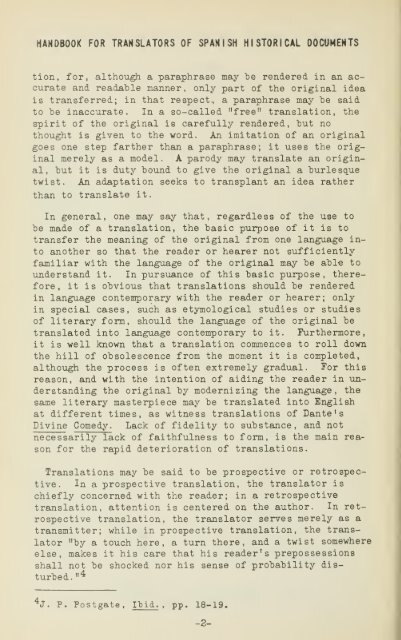Handbook for translators of Spanish historical ... - University Library
Handbook for translators of Spanish historical ... - University Library
Handbook for translators of Spanish historical ... - University Library
Create successful ePaper yourself
Turn your PDF publications into a flip-book with our unique Google optimized e-Paper software.
HANDBOOK FOR TRANSLATORS OF SPANISH HISTORICAL DOCUMENTS<br />
tion, <strong>for</strong>, although a paraphrase may 'he rendered in an accurate<br />
and readable manner, only part <strong>of</strong> the original idea<br />
is transferred; in that respect, a paraphrase may he said<br />
to "be inaccurate. In a so-called "free" translation, the<br />
spirit <strong>of</strong> the original is carefully rendered, hut no<br />
thought is given to the word. An imitation <strong>of</strong> an original<br />
goes one step farther than a paraphrase; it uses the original<br />
merely as a model. A parody may translate an original,<br />
but it is duty bound to give the original a burlesque<br />
twist. An adaptation seeks to transplant an idea rather<br />
than to translate it.<br />
In general, one may say that, regardless <strong>of</strong> the use to<br />
be made <strong>of</strong> a translation, the basic purpose <strong>of</strong> it is to<br />
transfer the meaning <strong>of</strong> the original from one lang\iage into<br />
another so that the reader or hearer not sufficiently<br />
familiar with the language <strong>of</strong> the original may be able to<br />
\inderstand it. In pursiiance <strong>of</strong> this basic purpose, there<strong>for</strong>e,<br />
it is obvious that translations should be rendered<br />
in language contemporary with the reader or hearer; only<br />
in special cases, such as etymological studies or studies<br />
<strong>of</strong> literary <strong>for</strong>m, should the language <strong>of</strong> the original be<br />
translated into language contemporary to it. Furthermore,<br />
it is well known that a translation commences to roll down<br />
the hill <strong>of</strong> obsolescence from the moment it is completed,<br />
although the process is <strong>of</strong>ten extremely gradual. For this<br />
reason, ajid with the intention <strong>of</strong> aiding the reader in \inderstanding<br />
the original by modernizing the language, the<br />
same literary masterpiece may be translated into English<br />
at different times, as witness translations <strong>of</strong> Dante's<br />
Divine Comedy. Lack <strong>of</strong> fidelity to substance, and not<br />
necessarily lack <strong>of</strong> faithfulness to <strong>for</strong>m, is the main reason<br />
<strong>for</strong> the rapid deterioration <strong>of</strong> translations.<br />
Translations may be said to be prospective or retrospective.<br />
In a prospective translation, the translator is<br />
chiefly concerned with the reader; in a retrospective<br />
translation, attention is centered on the author. In retrospective<br />
translation, the translator serves merely as a<br />
transmitter; while in prospective translation, the translator<br />
"by a touch here, a turn there, and a twist somewhere<br />
else, makes it his care that his reader's prepossessions<br />
shall not be shocked nor his sense <strong>of</strong> probability disturbed."'^<br />
'^J. P. Postgate, I"bid. , pp. 18-19.<br />
-2-










![Novellen [microform] - University Library](https://img.yumpu.com/21939450/1/171x260/novellen-microform-university-library.jpg?quality=85)
![Anecdota Chisiana de re metrica [microform]](https://img.yumpu.com/21939448/1/190x239/anecdota-chisiana-de-re-metrica-microform.jpg?quality=85)



![Schollenbruch [microform] : Gedichte - University Library](https://img.yumpu.com/21939437/1/174x260/schollenbruch-microform-gedichte-university-library.jpg?quality=85)

